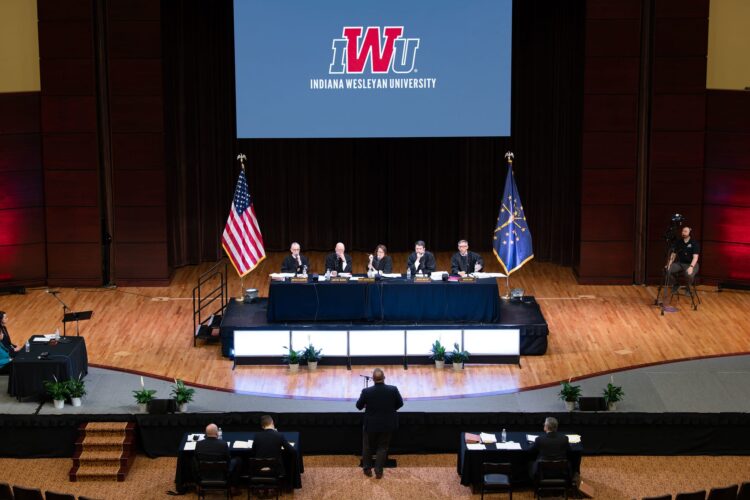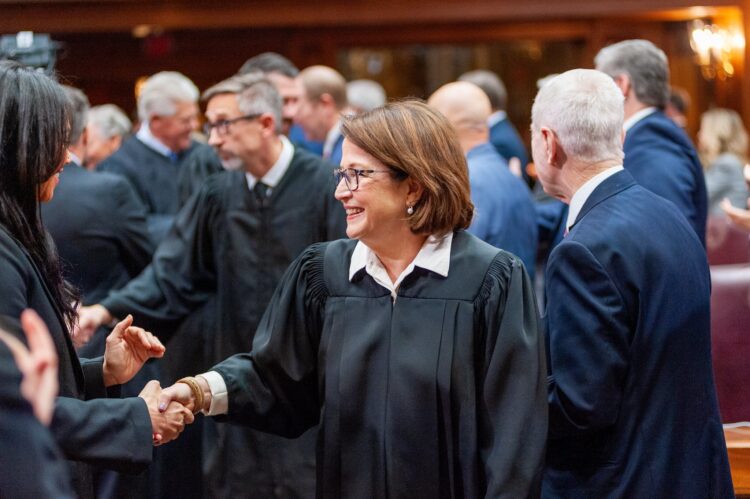
By Marilyn Odendahl
The Indiana Citizen
October 13, 2025
In a review of the Indiana Supreme Court’s 2024-25 fiscal year, statistics show the workload was about the same as in previous years, but Chief Justice Loretta Rush noted, the public has filed more complaints against attorneys, more lawyers have sought mental health counseling, and the judiciary has faced more threats.
The high court received 704 cases in this past fiscal year and heard 48 oral arguments. Justice Geoffrey Slaughter wrote the most majority opinions at 11 and Justice Christopher Goff wrote the most non-majority opinions, which includes concurrences and dissents, at 13.
“It’s just nice that, I think, our Indiana courts are boring,” Rush said during a news conference last week in the Supreme Court conference room about the 2024-25 annual report. She explained that the litigants who come before the Supreme Court get full written opinions when their cases are decided. Also, she said, the justices work hard and keep themselves out of the political process.
“We want a court system like we have in Indiana that (doesn’t) depend on which way the winds are blowing at any given time,” Rush continued. “So, I’ll stay boring and hard working. I think that works.”
While the number of cases filed with the Supreme Court was down from the 748 and 717 received in fiscal years 2023-24 and 2022-23, respectively, the justices ruled on two appeals from death row. Prior to these capital appeals from inmates Joseph Corcoran and Benjamin Ritchie, who were executed in 2024 and 2025, respectively, the last execution case to come before the court was likely in 2009 when Matthew Wrinkles was put to death.
The orders from the Supreme Court in Corcoran v. State and Ritchie v. State, permitting the executions to proceed, were both signed by Rush. In Corcoran, Rush concurred and Goff dissented in separate opinions. In Ritchie, Slaughter concurred in a separate opinion which Justice Derek Molter joined while Goff dissented in part and concurred in part with Rush joining, in part, Goff’s opinion and dissenting in her own opinion. Justice Mark Massa recused himself from the proceeding.

In other decisions, the Supreme Court ruled in cases of first impression, finding courts may consider a petitioner’s advanced age in an adoption hearing; resolving three issues under the Medical Malpractice Act; and holding defendants may benefit from hindsight when it reveals they acted in self-defense. Also, the court found Indiana University could be held liable for a window that fell on a student; affirmed trial court rulings which allowed plaintiffs to see three documents from the Indiana Election Division; and a memo from the Family & Social Services Administration under the Access to Public Records Act; and provided a statutory road map for Child in Need of Services (CHINS) cases.
“They’re all big,” Rush said of the cases that come before the Supreme Court. “Even if it’s a small one, if your liberty’s at state, we take it pretty seriously.”
Every Thursday, the justices gather around a large wooden table crafted by inmates at the Pendleton Correctional Facility and review the petitions to transfer that have been filed, which ask the court to hear the cases. When cases are accepted, the justices will again sit at the table after oral arguments to discuss the legal issues being presented. Rush assigns a justice to write the majority opinion and as the opinion gets drafted and circulated between the justices, they will convene for more discussions.
“As a court of last resort, you sort of have to hammer every word in because it can come back,” Rush said, explaining the importance of writing the opinions so people understand what the Supreme Court has ruled. “I’ve been an attorney and judge for almost 43 years. I can remember reading opinions and saying, ‘What are you saying?’ We want to try to make it as clear as possible. … We want to explain not only to the party that is successful, but to the (other) party on why they weren’t successful in their case.”

In the 2024-25 fiscal year, 1,639 grievances were filed against Indiana attorneys, up from the 1,499 and 1,395 grievances submitted during the 2023-24 and 2022-23 fiscal years, respectively. As is typical, a majority of the complaints, 1,535, were summarily dismissed last fiscal year as presenting no valid issue of misconduct.
The complaints lodged against judges actually declined in fiscal year 2024-25 to 773 from 824 in the 2023-24 fiscal year. But the number of formal judicial discipline charges reached four, compared to one in the respective fiscal years.
At the same time, more legal professionals are reaching out to the Judges and Lawyers Assistance Program for help. The number of calls to JLAP rose to 464 in the 2024-25 fiscal year, up from 364 in the previous fiscal year, with mental health issues, situational stressors and substance abuse being the top reasons for the requests for assistance.
Moreover, Rush said that threats to the judiciary are at an “all-time high” with judges being cussed out by litigants, brawls taking place in the courtrooms and personal safety being endangered. The annual report does not provide any data or statistics on threats, but during the Indiana House Ways and Means Committee hearing in January, the chief justice said a number of Indiana judges and their families have been threatened and she asked for $1.5 million in seed money to provide matching grants to counties to improve security in courthouses and courtrooms. The legislature did not provide the funding.
Rush attributed the increase in threats to the nature of the court’s work.
“I just think temperatures are up in the courtroom,” Rush said at the news conference. “I’ve always said the courts … deal with people at their most vulnerable moments, whether it’s violence, child termination cases, paternity cases, custody cases. We are the government emergency rooms of some of society’s toughest issues right now.”
Dwight Adams, an editor and writer based in Indianapolis, edited this article. He is a former content editor, copy editor and digital producer at The Indianapolis Star and IndyStar.com, and worked as a planner for other newspapers, including the Louisville Courier Journal.
The Indiana Citizen is a nonpartisan, nonprofit platform dedicated to increasing the number of informed and engaged Hoosier citizens. We are operated by the Indiana Citizen Education Foundation, Inc., a 501(c)(3) public charity. For questions about the story, contact Marilyn Odendahl at marilyn.odendahl@indianacitizen.org.